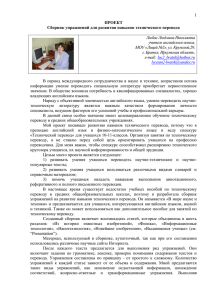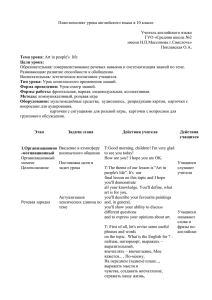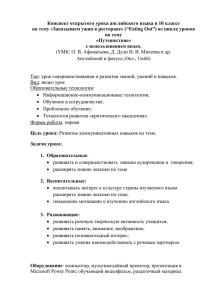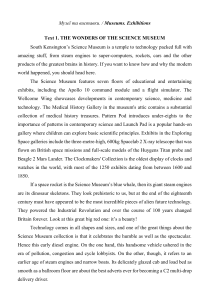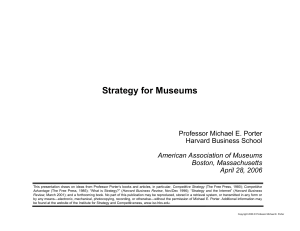Методическая разработка урока по английскому языку в 8 классе по теме:
реклама
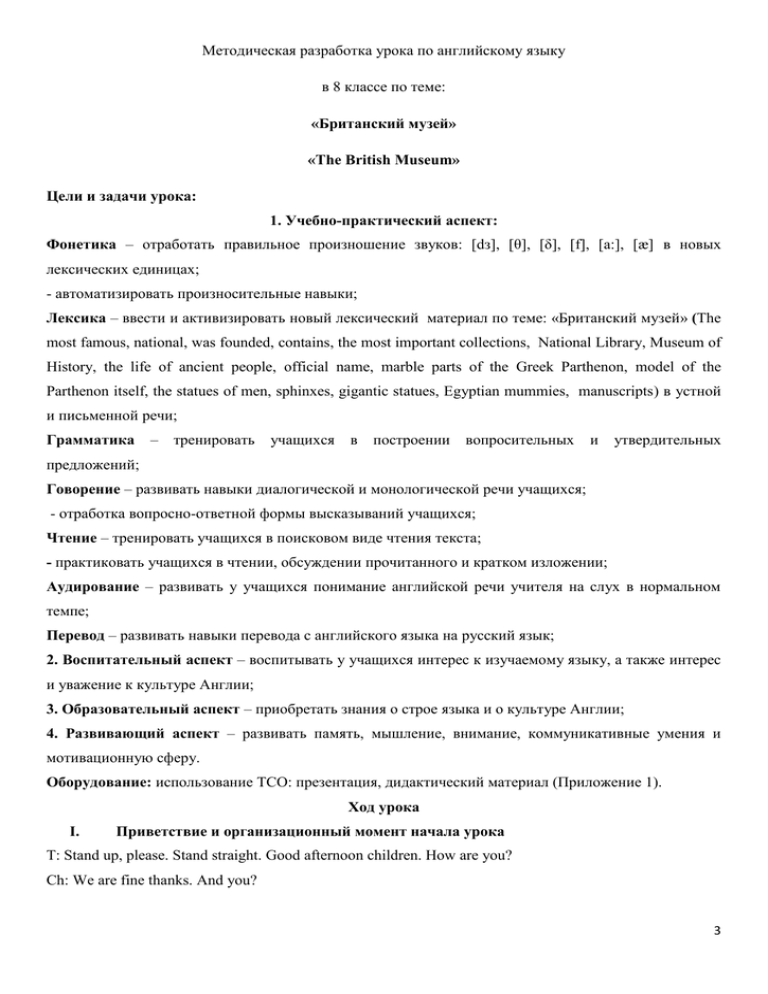
Методическая разработка урока по английскому языку в 8 классе по теме: «Британский музей» «The British Museum» Цели и задачи урока: 1. Учебно-практический аспект: Фонетика – отработать правильное произношение звуков: [dз], [θ], [δ], [f], [a:], [æ] в новых лексических единицах; - автоматизировать произносительные навыки; Лексика – ввести и активизировать новый лексический материал по теме: «Британский музей» (The most famous, national, was founded, contains, the most important collections, National Library, Museum of History, the life of ancient people, official name, marble parts of the Greek Parthenon, model of the Parthenon itself, the statues of men, sphinxes, gigantic statues, Egyptian mummies, manuscripts) в устной и письменной речи; Грамматика – тренировать учащихся в построении вопросительных и утвердительных предложений; Говорение – развивать навыки диалогической и монологической речи учащихся; - отработка вопросно-ответной формы высказываний учащихся; Чтение – тренировать учащихся в поисковом виде чтения текста; - практиковать учащихся в чтении, обсуждении прочитанного и кратком изложении; Аудирование – развивать у учащихся понимание английской речи учителя на слух в нормальном темпе; Перевод – развивать навыки перевода с английского языка на русский язык; 2. Воспитательный аспект – воспитывать у учащихся интерес к изучаемому языку, а также интерес и уважение к культуре Англии; 3. Образовательный аспект – приобретать знания о строе языка и о культуре Англии; 4. Развивающий аспект – развивать память, мышление, внимание, коммуникативные умения и мотивационную сферу. Оборудование: использование ТСО: презентация, дидактический материал (Приложение 1). Ход урока I. Приветствие и организационный момент начала урока T: Stand up, please. Stand straight. Good afternoon children. How are you? Ch: We are fine thanks. And you? 3 T: I’m fine too thanks. Sit down, please. Who is on duty today? What date is it today? What day is it today? Good for you. T: So let’s begin our English lesson. Our topic is: “Museum of London – The British Museum”. Who can translate it? T: Good for you. II. Основная часть урока 1. Речевая зарядка. T: We spoke about Misha and Robin at the last lesson. Do you remember? Ok, answer my questions, please. T: Where did Misha and Robin go to sleep? Ch: Misha and Robin went to sleep in the Natural History Museum. T: What did they see in the Natural History Museum? Ch: They saw witches, ghosts and monsters. T: Who organizes sleepovers? Ch: Museums do it for children at Halloween time. T: When do they organize sleepovers? Ch: They organize sleepovers in the evening? T: What do children do in the evening? Ch: Children play games, make costumes and masks. T: Do children like sleepovers? Ch: Yes, they do. Because it’s very fun. T: Good for you. T: And today we are going to visit The British Museum. Дотекстовый этап 2. Введение новых лексических единиц T: But at first let’s read new words. Look at the blackboard and repeat after me. ( учащиеся повторяют слова за учителем); T: And now let’s read one by one. (учащиеся читают по цепочке) 1. The most famous – самый знаменитый 2. national – национальный 3. was founded – был основан 4. contains - содержаться 5. the most important collections – самые значительные коллекции 6. the National Library – национальная библиотека 7. Museum of History – музей истории 8. the life of ancient people – жизнь древних людей 4 9. official name – официальное название 10. marble parts of the Greek Parthenon – мраморные предметы из Греческого Парфенона 11. model of the Parthenon itself – модель самого Парфенона 12. the statues of men – статуи людей 13. sphinxes – сфинксы 14. gigantic statues – гигантские статуи 15. Egyptian mummies –египетские мумии 16. manuscripts – манускрипты T: Good for you. 3. Отработка лексического материала Fill in the missing letters and read the words. (вставить пропущенные буквы в слова). T: Ok, look at the blackboard. This task you must fill in the missing letters and then read the words. (Учащиеся вставляют буквы в слова); 1. Nat…onal 2. C…ntains 3. the Nati…nal Libra…y 4. M…seum of Hi…tory 5. Of…icial name 6. Mar…le parts 7. the Gre…k Part…enon 8. Sphin…es 9. Gig…ntic statues 10. Eg…ptian mummies 11. Man…scripts T: We have two minutes. (Учащимся дается несколько минут). T: Time is up, and now I am going to check your work. (в этом задании можно взять несколько работ на проверку, это задание особенно характерно для слабых учащихся). T: And now look at the blackboard and check your works. 4. Explains the words: Parthenon, sphinxes, Egyptian mummy, manuscript. T: Ребята, давайте вспомним древнею историю и попробуем объяснить происхождение некоторых слов. Parthenon – Парфенон, sphinxes – сфинксы, Egyptian mummy – египетская мумия, manuscript – манускрипт. (учащиеся объясняют слова). 5 5. Match the words and the pictures. (в этом задании учащиеся должны найти соответствующую картинку (слайд №6) и соединить ее с нужным объяснением) 1. marble parts of the Greek Parthenon; 2. model of the Parthenon itself; 3. the statues of men; 4. Manuscripts; 5. Sphinxes; 6. gigantic statues; 7. Egyptian mummies T: (это задание может выполнить один из учащихся класса). T: Good for you. Текстовый этап. 6. Answer the questions. (ответить на вопросы) T: Ok, listen to me please and look at the blackboard. And now you must answer the questions, before you must read the text. (В этом задании учащимся предлагается ответить на вопросы по тексту, с учетом, что учащимся дается только несколько минут, чтобы изучить текст, который находится на слайде №7). T: We have two minutes. (учащиеся просматривают текст). (Учитель задает вопросы (слайд №8), учащиеся отвечают по тексту). 1. What national museum is the most famous? 2. When was it founded? 3. What is its official name? 4. What can you learn in the British Museum? 5. What collections are there in the British Museum? 6. What does the National Library contain? 7. Translate the text. T: And now let’s translate the text. You must translate the sentences which I am going to read. Do you understand me? (В этом задании учащиеся должны перевести предложения, которые им предлагает учитель, предложения даются из текста). 1. The most famous national museum in London is the British Museum. 2. It was founded in 1753. 3. At this museum you can learn about the life of ancient people. 6 4. Such as the marble parts of the Greek Parthenon, model of the Parthenon itself, the statues of men and horses, sphinxes, gigantic statues and Egyptian mummies. 5. The National Library contains one of the richest collections of books and manuscripts in the world. Послетекстовый этап 8. Complete the words where necessary. (дополнить предложения в тексте) T: Look at the blackboard. And now I want you to fill in the gaps. The most famous … … in London is the British Museum. The British Museum is one of the worlds – famous museums. It was … in 1753. The British Museum … the most important collections in Britain. Its official … is the National Library and Museum of History. At this museum you … learn about the … of ancient … such as the marble … of the Greek Parthenon, model of the Parthenon …, the statues of … and horses, sphinxes, gigantic … and Egyptian mummies. The National Library contains one of the … collections of books and … in the world. III. Заключительная часть 1. Подведение итога урока. T: So boys and girls tell me please what national museum is the most famous? And when was it founded? T: Good for you. T: Children let’s remember collections of the British Museum in London once more. (учащиеся перечисляют коллекцию музея на английском языке); T: Let’s read new words once more. 2. Домашние задание. T: Open your diaries, take your pen and write down your home task (in the written). 3. Прощание. T: The lesson is over you may be free. T: Good buy. Ch: 7 Приложение 1 Раздаточный материал для учащихся 8 класса Задание New vocabulary: 1. The most famous – самый знаменитый 2. national – национальный 3. was founded – был основан 4. contains - содержаться 5. the most important collections – самые значительные коллекции 6. the National Library – национальная библиотека 7. Museum of History – музей истории 8. the life of ancient people – жизнь древних людей 9. official name – официальное название 10. marble parts of the Greek Parthenon – мраморные предметы из Греческого Парфенона 11. model of the Parthenon itself – модель самого Парфенона 12. the statues of men – статуи людей 13. sphinxes – сфинксы 14. gigantic statues – гигантские статуи 15. Egyptian mummies –египетские мумии 16. manuscripts – манускрипты 1. Задание Fill in the missing letters and read the words. 1. Nat…onal 2. C…ntains 3. the Nati…nal Libra…y 4. M…seum of Hi…tory 5. Of…icial name 6. Mar…le parts 7. the Gre…k Part…enon 8 8. Sphin…es 9. Gig…ntic statues 10. Eg…ptian mummies 11. Man…scripts 3.Задание Match the words and the pictures. Write the letters opposite numbers. 1. 2. 3. 4. 5. 6. 7. 4. Задание Museum of London Complete the words where necessary. The most famous … … in London is the British Museum. The British Museum is one of the worlds – famous museums. It was … in 1753. The British Museum … the most important collections in Britain. Its official … is the National Library and Museum of History. At this museum you … learn about the … of ancient … such as the marble … of the Greek Parthenon, model of the Parthenon …, the statues of … and horses, sphinxes, gigantic … and Egyptian mummies. The National Library contains one of the … collections of books and … in the world. 9
